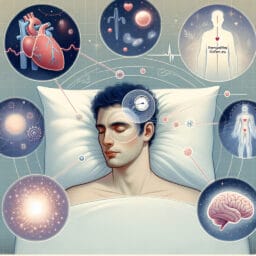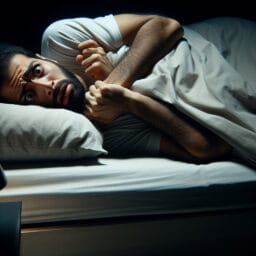
Unraveling The Mysteries: Defining Sleepwalking and Its Causes
Table of Contents
- Introduction
- Defining Sleepwalking
- Causes of Sleepwalking
- Effects of Sleepwalking
- Managing Sleepwalking
- Conclusion
- Frequently Asked Questions
Introduction
Surprisingly, sleepwalking, a known NREM disorder, is not simply about walking during sleep. It involves a range of complex actions performed while one is in deep sleep, making it an intriguing and essential area of medical education. As the sleeping person may exhibit various complex activities such as talking, sitting up or even driving a car during a sleepwalking episode, this sleep disorder poses risks beyond what we might initially imagine.
Studies have shown that certain factors can trigger sleepwalking – primarily issues like lack of sufficient rest and extreme fatigue. Sleep deprivation indeed plays an instrumental role in increasing the frequency of these episodes. Excessive daytime sleepiness has also been noted as one of the symptoms following a night filled with such disturbances.
Addressing these risk factors could help prevent sleepwalking to some extent; however healthcare professionals warn against considering these preventive measures as absolute solutions. A systematic review by several renowned sleep doctors suggests that adults experiencing persistent episodes should undergo a comprehensive sleep study for proper diagnosis and treatment.
This brings us to the question: how is adult’s sleepwalking treated? While there isn’t one definitive answer due to its complex nature, the first step often revolves around enhancing bed-time routines and environments to ensure they are conducive for restful slumber. Understanding our unique relationship with ‘sleep’ and ‘sleep disorders’ like this one helps us navigate towards healthier sleeping patterns while minimizing potential dangers associated with them.
Defining Sleepwalking
Sleepwalking, medically termed as a form of NREM parasomnias, is indeed an intriguing sleep disorder that involves more than mere walking during sleep. It’s a complex phenomenon where the individual performs varying activities in a state of deep sleep – from simple actions like talking or sitting up to potentially dangerous behaviors such as driving. Misunderstandings abound when it comes to this condition; for instance, contrary to popular belief, sleepwalkers are not acting out their dreams but are rather in a transitional state between deep slumber and wakefulness.
A host of symptoms may indicate sleepwalking episodes: talking during sleep, little memory of the event or even excessive daytime sleepiness following these nocturnal escapades. However, diagnosis isn’t straightforward and often requires expert intervention by a qualified sleep doctor who might recommend undergoing a comprehensive sleep study. This procedure helps identify underlying conditions like sleep apnea that could trigger these episodes.
It’s noteworthy that several risk factors increase susceptibility towards this disorder – the most significant being acute sleep deprivation. Hence preventive measures primarily revolve around ensuring sufficient rest and healthy sleeping environments to mitigate chances of adults experiencing persistent instances of this disorder. Yet, remember that while these steps may help prevent some instances of people wandering off in their slumber, they aren’t guaranteed solutions nor do they make one immune against this peculiar medical condition known as adult’s Sleepwalking.
| Defining Sleepwalking | |
|---|---|
| Description | A complex sleep disorder where the individual performs varying activities from simple actions to potentially dangerous behaviors during a state of deep sleep. |
| Common Misconception | Sleepwalkers are not acting out their dreams but are in a transitional state between deep sleep and wakefulness. |
| Indicative Symptoms | Talking during sleep, little memory of the event or excessive daytime sleepiness. |
| Diagnosis | Often requires expert intervention by a qualified sleep doctor who might recommend a comprehensive sleep study to identify underlying conditions. |
| Risk Factors | Acute sleep deprivation is the most significant risk factor. |
| Preventive Measures | Ensuring sufficient rest and healthy sleeping environments. However, these measures aren’t guaranteed solutions. |
Causes of Sleepwalking
Sleepwalking, a complex sleep disorder marked by a range of perplexing activities during deep sleep, is much more than the simple act of walking while asleep. Sleepwalkers can perform an array of intricate tasks such as talking, sitting up or even engaging in potentially hazardous activities like driving – all while remaining unconscious. The root causes often point to both genetic and environmental risk factors that trigger sleepwalking episodes. For instance, those who are severely sleep deprived are more prone to these nocturnal escapades; it’s one reason why ensuring adequate rest can help prevent sleepwalking to some extent. However, it’s important to note that preventive measures aren’t foolproof solutions.
Another intriguing aspect involves the psychological factors associated with this NREM disorder. High levels of stress or anxiety could potentially exacerbate these occurrences; hence maintaining mental well-being becomes equally crucial in managing this condition. Furthermore, individuals may exhibit excessive daytime sleepiness following a night filled with such disturbances – another symptom indicating potential sleep disorders.
A comprehensive understanding is pivotal for effective management and treatment of adult’s sleepwalking – be it through enhancing bedtime routines or even professional intervention from a qualified sleep doctor undertaking systematic reviews and thorough examinations like a detailed sleep study. This not only aids in detecting underlying conditions (such as possible risks from severe cases like Sleep Apnea) but also helps tailor individualistic approaches towards healthier slumber patterns thereby limiting potential dangers associated with this baffling yet fascinating world of NREM parasomnias.
Effects of Sleepwalking
The world of sleep disorders, particularly the baffling phenomenon of sleepwalking, is no longer cloaked in mystery thanks to advances in medical education. Sleepwalking, a complex NREM disorder, involves intricate activities performed by an individual while they are in deep sleep. The sight of a sleeping person engaging in complex actions such as walking around, talking or even performing tasks can be both fascinating and unsettling. The root cause often involves a combination of risk factors including genetic predisposition and environmental triggers like acute sleep deprivation.
Sleepwalking episodes aren’t confined to mere nocturnal wanderings; these instances can have profound physiological and psychological effects on the affected individual. Physically, this could manifest as chronic fatigue due to disturbed slumber patterns or even potential injuries sustained during these unconscious escapades. Psychologically speaking, it’s not uncommon for individuals experiencing repeated incidences to suffer from anxiety or excessive daytime sleepiness – symptoms that can drastically affect their daily lives.
As if navigating through these challenges weren’t enough, the social implications can further compound the issue. Misunderstandings about this puzzling condition abound; thus making those who experience frequent episodes potentially susceptible to stigmatization or ridicule.
Sleep deprivation only serves to exacerbate these effects – nudging an already precarious situation towards potential hazards by increasing both frequency and intensity of these nighttime ventures. Comprehensive solutions must therefore involve multi-faceted approaches that address all facets from ensuring sufficient restful slumber and adopting preventive measures against triggers like stress or anxiety to seeking professional help whenever necessary. Undergoing comprehensive evaluations such as systematic reviews and detailed sleep studies under expert guidance from qualified sleep doctors are pivotal components when it comes tackling this intriguing yet perplexing NREM parasomnia known as adult’s sleepwalking.
Managing Sleepwalking
An in-depth understanding of sleepwalking, a fascinating yet complex NREM disorder, is essential not just for those grappling with it but also for anyone interested in the intricacies of sleep disorders. Defined by complex activities executed during deep sleep, from talking to walking or even driving, this nighttime phenomenon intrigues and challenges medical experts worldwide. Noteworthy risk factors like severe sleep deprivation make individuals more prone to these nocturnal escapades. The role of a sleep doctor becomes pivotal here – they can initiate a comprehensive systematic review of the patient’s symptoms and recommend detailed assessments such as a full-fledged sleep study if needed.
Medical treatments including medication are sometimes employed to treat persistent adult’s sleepwalking; however, lifestyle changes often play an equally significant role. Creating restful bedtime routines and managing one’s mental well-being are preventive measures that cannot be overlooked as they collectively help enhance the quality of slumber thereby reducing episodes.
Moreover, psychological interventions have proven fruitful in helping people manage their patterns better and navigate through potential triggers that could lead to an episode. From stress management techniques to cognitive behavioral therapy (CBT), such strategies contribute towards reducing anxiety related to regular episodes and offer additional support alongside physical treatments. Grappling with excessive daytime sleepiness or coping with societal misunderstandings need not be daunting anymore once armed with accurate knowledge about this captivating area within medical education – Sleepwalking.
| Aspect | Details |
|---|---|
| Definition | Sleepwalking is defined as complex activities executed during deep sleep, including talking, walking, or even driving. |
| Risk Factors | Severe sleep deprivation. |
| Role of Sleep Doctor | A sleep doctor can initiate a comprehensive systematic review of the patient’s symptoms and recommend detailed assessments such as a full-fledged sleep study if needed. |
| Treatments | Medication, lifestyle changes (including restful bedtime routines and managing one’s mental well-being), and psychological interventions such as stress management and cognitive behavioral therapy (CBT). |
| Additional Support | Psychological interventions help manage triggers and reduce anxiety related to regular episodes. They also offer additional support alongside physical treatments. |
| Image |
Conclusion
Beneath the tranquil cloak of night, a sleepwalker might be seen engaging in complex activities while entirely unconscious – a startling manifestation of their deep-seated NREM parasomnia. Sleepwalking, more than just walking during sleep, has proven to be an intriguing area within medical education due to its perplexing combination of risk factors and symptoms. Severe sleep deprivation is often tied to increased frequency of these nocturnal escapades. Yet, it’s not simply about reducing fatigue; comprehensive preventive measures also include addressing mental well-being and creating restful bed-time routines for those affected by this disorder. Further complicating matters is that one hardly remembers such episodes, making diagnosis challenging without professional help from a sleep doctor who can direct systematic reviews or recommend detailed assessments like a full-fledged sleep study. The role played by such studies is pivotal as they could reveal underlying conditions like sleep apnea that could trigger this condition. Indeed, continued research in understanding the variables leading to adults experiencing these episodes seems crucial if we aim to manage this NREM disorder effectively and ensure safer nights for all.



